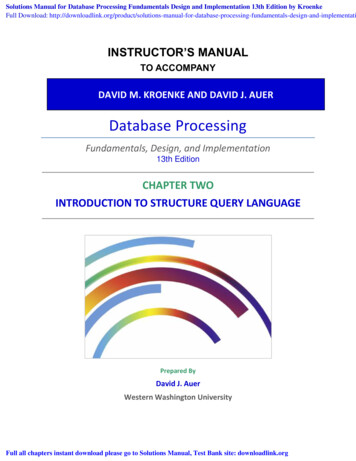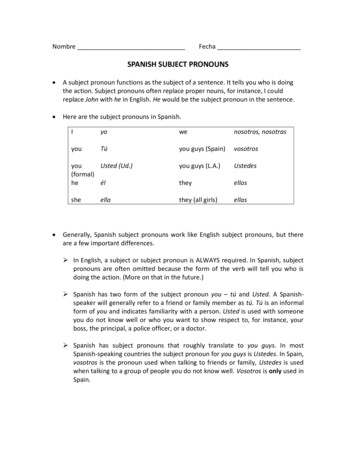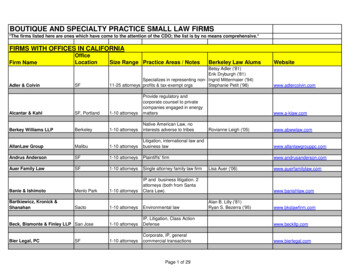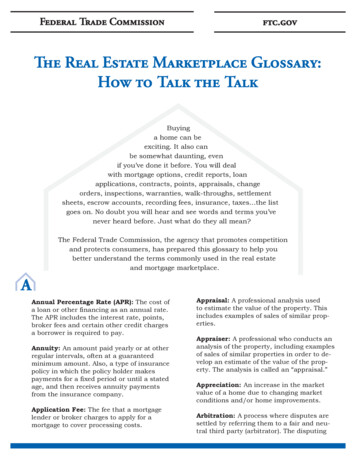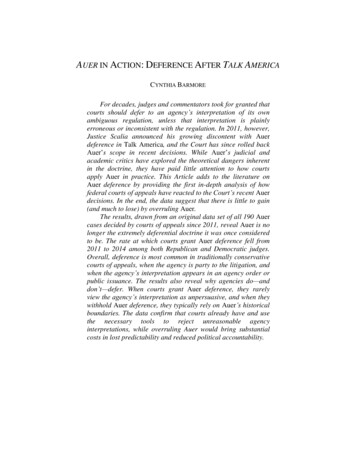
Transcription
AUER IN ACTION: DEFERENCE AFTER TALK AMERICACYNTHIA BARMOREFor decades, judges and commentators took for granted thatcourts should defer to an agency’s interpretation of its ownambiguous regulation, unless that interpretation is plainlyerroneous or inconsistent with the regulation. In 2011, however,Justice Scalia announced his growing discontent with Auerdeference in Talk America, and the Court has since rolled backAuer’s scope in recent decisions. While Auer’s judicial andacademic critics have explored the theoretical dangers inherentin the doctrine, they have paid little attention to how courtsapply Auer in practice. This Article adds to the literature onAuer deference by providing the first in-depth analysis of howfederal courts of appeals have reacted to the Court’s recent Auerdecisions. In the end, the data suggest that there is little to gain(and much to lose) by overruling Auer.The results, drawn from an original data set of all 190 Auercases decided by courts of appeals since 2011, reveal Auer is nolonger the extremely deferential doctrine it was once consideredto be. The rate at which courts grant Auer deference fell from2011 to 2014 among both Republican and Democratic judges.Overall, deference is most common in traditionally conservativecourts of appeals, when the agency is party to the litigation, andwhen the agency’s interpretation appears in an agency order orpublic issuance. The results also reveal why agencies do—anddon’t—defer. When courts grant Auer deference, they rarelyview the agency’s interpretation as unpersuasive, and when theywithhold Auer deference, they typically rely on Auer’s historicalboundaries. The data confirm that courts already have and usethe necessary tools to reject unreasonable agencyinterpretations, while overruling Auer would bring substantialcosts in lost predictability and reduced political accountability.
CUDAHY COMPETITION SUBMISSION2015]6/16/2015AUER IN ACTION2TABLE OF CONTENTSINTRODUCTION .2I. VIEW FROM THE TOP: AUER DEFERENCE .6A. AUER’S CRITICS AND DEFENDERS .6B. A NARROWING DOCTRINE .6II. VIEW FROM THE GROUND:AUER IN THE COURTS OF APPEALS .15A. METHODOLOGY .15B. WHAT THE COURT HAS ALREADY ACCOMPLISHEDBY NARROWING AUER .15C. WHEN COURTS OF APPEALS GRANT OR REJECT AUER .19D. WHY COURTS OF APPEALS GRANT OR REJECT AUER.19III. IMPLICATIONS FOR REVISITING AUER .29A. THE SIZE OF THE PROBLEM: THINKING ABOUTAUER’S PRACTICALITIES .29B. THE COSTS OF THE SOLUTION: ALTERNATIVES TO AUER .32CONCLUSION .37INTRODUCTIONFor decades, judges and commentators took for granted that courtsshould defer to agency interpretations of their own regulations. Thisdoctrine, interchangeably called Auer or Seminole Rock deference, is astaple of administrative law.1 It instructs that “[w]hen an agency interpretsits own regulation, the Court, as a general rule, defers to it ‘unless thatinterpretation is plainly erroneous or inconsistent with the regulation.’”2 In1Auer v. Robbins, 519 U.S. 452 (1997); Bowles v. Seminole Rock & Sand Co.,325 U.S. 410 (1945).2Decker v. Nw. Envtl. Def. Ctr., 133 S. Ct. 1326, 1337 (2013) (quoting ChaseBank USA, N.A. v. McCoy, 131 S. Ct. 871, 880 (2011)).
CUDAHY COMPETITION SUBMISSION36/16/2015DE FERENCE AFTER TALK AMERICAcontrast to Chevron deference, which urges courts to adopt reasonableagency interpretations of the statutes they administer,3 Auer deference dealswith agency interpretations of the regulations they write. Ultimately, Auerleaves defining the scope of an ambiguous regulation largely to the agencythat promulgated it.In recent years, however, some Justices on the Supreme Court havepicked up on academic criticism of Auer. They have been raising thedoctrine’s profile and working to scale it back in a series of recentdecisions, leading Auer to be described as under siege. 4 While courtsoriginally deferred to all but plainly erroneous or inconsistentinterpretations,5 the Court has narrowed Auer to withhold deference wherethe interpretation causes unfair surprise,6 or where the underlying regulationparrots the statutory language7 or is unambiguous.8 Many have urged theCourt to overrule Auer entirely,9 and at least three members of the Courthave announced their willingness to consider it.10The debate so far has been largely theoretical, centering on Auer’sincentives for agencies, its risks to separation of powers, and the practicalbenefits at stake.11 An emerging literature has begun to trace the Court’s3Chevron, U.S.A., Inc. v. Natural Res. Def. Council, Inc., 467 U.S. 837, 843-44(1984).4See Jeffrey Pojanowski, More on Agency Interpretations of Regulations:Taking Deference Seriously, YALE J. ON REG. NOTICE & COMMENT (Oct. 8, iously-by-jeffrey-pojanowski.5Auer, 519 U.S. at 461.6Christopher v. SmithKline Beecham Corp., 132 S. Ct. 2156 (2012).7Gonzales v. Oregon, 546 U.S. 243 (2006).8Christensen v. Harris Cnty., 529 U.S. 576, 588 (2000).9See, e.g., Peri & Sons Farms, Inc. v. Rivera, 735 F.3d 892 (9th Cir. 2013),cert. denied, 134 S. Ct. 2819 (2014) (No. 13-950).10See Decker v. Nw. Envtl. Def. Ctr., 133 S. Ct. 1326, 1338 (2013) (Roberts,C.J., concurring); id. at 1341 (Scalia, J., concurring in part and dissenting in part).11Compare John F. Manning, Constitutional Structure and Judicial Deferenceto Agency Interpretations of Agency Rules, 96 COLUM. L. REV. 612, 680-81 (1996)(arguing against Auer), with Scott H. Angstreich, Shoring Up Chevron: A Defenseof Seminole Rock Deference to Agency Regulation, 34 U.C. DAVIS L. REV. 49,112-16 (2000) (arguing in favor of Auer).
CUDAHY COMPETITION SUBMISSION2015]6/16/2015AUER IN ACTION4recent decisions narrowing Auer,12 but little attention has been paid to howlower courts apply Auer or the effects of those decisions in lower courts.13As the Court considers overruling Auer, it should be aware of how courts ofappeals apply the doctrine in practice, and what the Court has alreadyaccomplished through its recent Auer jurisprudence.This Article adds to the emerging literature on Auer deference byproviding a window into how federal courts of appeals apply Auer and howthey have reacted to the Court’s recent Auer decisions. Drawing on anoriginal data set of 190 cases, which includes all Auer cases decided bycourts of appeals since 2011 when Justice Scalia first announced his interestin reconsidering the doctrine, 14 this Article focuses on Auer’s practicaldimensions. Part I provides a conceptual background for the discussion,offering an overview of common arguments for and against Auer, andtracing the Court’s recent Auer jurisprudence. Part II draws lessons from thedata, and Part III uses these insights to weigh the costs and benefits ofoverruling Auer. The results reveal several important findings:First, courts of appeals have responded to the Court’s recent Auerdecisions by narrowing their application of the doctrine, leading to a steadydecline from 2011 to 2014 in the rate at which courts grant Auer deference.Between 2011 and 2012, courts granted Auer deference in 82.3% of cases.Since the Court’s 2013 decision in Decker v. Northwest EnvironmentalDefense Center,15 that rate has fallen to 70.6%. For critics concerned thatAuer is a form of super-deference that requires courts to adopt ill-reasonedagency interpretations, the data show that courts of appeals now have—anduse—a variety of tools to reject improper agency interpretations. There isalso no evidence that political ideology has driven the change. Rather,12See, e.g., Michael P. Healy, The Past, Present and Future of Auer Deference:Mead, Form and Function in Judicial Review of Agency Interpretations ofRegulations, 62 KAN. L. REV. 633 (2014).13The most in-depth treatment to-date is a study of Auer deference in courts ofappeals and district courts, which measured the overall rate of deference during1999-2001 and 2005-07. See Richard J. Pierce, Jr. & Joshua Weiss, An EmpiricalStudy of Judicial Review of Agency Interpretations of Agency Rules, 63 ADMIN. L.REV. 515, 519 (2011). That study, however, did not explore factors for when orwhy those courts granted deference, and it did not consider the post-Talk Americaperiod.14Talk Am., Inc. v. Mich. Bell Tel. Co., 131 S. Ct. 2254, 2266 (2011) (Scalia,J., concurring).15133 S. Ct. at 1326.
CUDAHY COMPETITION SUBMISSION56/16/2015DE FERENCE AFTER TALK AMERICAdeference has fallen over time among judges appointed by both Republicanand Democratic presidents.Second, the data show when courts defer and the factors thatcorrespond to the highest rates of Auer deference. Historically conservativecircuits, including the Fifth, Eighth, and Eleventh, grant Auer deferencemost often, while the Ninth and D.C. Circuits are markedly more hesitant.Some agencies invoke Auer more often than others, particularly theDepartment of Labor and the Bureau of Immigration Affairs, but thoseagencies also receive it at lower rates than others. An agency’sinterpretation prevails more often when the agency is party to the litigationthan when it is not, but the court regularly refuses to defer if the agency’sinterpretation simply appears in its party brief. Instead, courts defer mostoften when the interpretation appears in the agency’s order or publicissuance.Third, the data reveal two key lessons about why courts do or do notdefer. First, among courts that grant Auer deference, it is extremely rare fora court to indicate that Auer requires it to adopt an interpretation it wouldotherwise reject. Instead, most courts use Auer as a shortcut to avoidlengthy regulatory analysis or conclude that the agency’s position is areasonable exercise of discretion to decide an unanswered policy question.Second, among courts that reject Auer deference, they typically rely onAuer’s traditional boundaries. Rather than use one of the Court’s new limitson Auer, most courts of appeals that withhold deference simply reason thatthe agency’s interpretation is plainly erroneous, inconsistent with theregulation, or not the product of the agency’s fair and considered judgment.It is only a matter of time before the Court decides to revisit Auer.16When it does, it can draw on these results to better understand the role Auerhas played since Talk America. The results demonstrate that the Court hasalready accomplished a significant amount with its recent Auer decisions,and common concerns about Auer have not materialized in practice. Courtstoday can and do reject inappropriate agency interpretations within Auer’sexisting framework. In sum, Auer already has meaningful limits, andoverruling Auer would accomplish little beyond removing a useful tool thatfacilitates judicial review and increases the predictability of regulatoryaction.Id. at 1339 (Roberts, C.J., concurring) (“The bar is now aware that there issome interest in reconsidering [Auer], and has available to it a concise statement ofthe arguments on one side of the issue.”).16
CUDAHY COMPETITION SUBMISSION2015]6/16/2015AUER IN ACTION6I. VIEW FROM THE TOP: AUER DEFERENCEA. Auer’s Critics and DefendersSince the mid-1990s, Auer deference has attracted increasingattention among academics and spurred an emerging literature on itsbenefits and costs. Underlying much of the discussion is a sense that Auer isa forceful form of deference that all but insulates agency action fromreview, compelling courts to adopt unsupported agency interpretations oftheir own regulations.17 That reputation stems from a 2008 study that foundthe Court granted Auer deference in 91% of relevant cases, making Auer thesecond strongest form of deference after Curtiss-Wright for executiveinterpretations related to foreign affairs and national security.18 While theexisting literature on Auer suggests a less deferential picture in the courts ofappeals,19 courts have called Auer “extremely deferential,”20 and academiccommentators observe the doctrine remains a “potent tool of policymaking.”21Auer’s critics have seized on the doctrine’s power as a starting pointfor opposing its continued use. Because Auer removes the court’s discretionto reject an agency’s improper (but permissible) interpretation, they argue,it places decisionmaking power in the agency and removes the court’sability to independently decide the meaning or application of an agency’sregulation. 22 Critics offer a formalist objection to Auer, contending itSee, e.g., Healy, supra note 12, at 680, 693 (“For many years, courts haveemployed a very deferential standard of review . . . [that] has been widely acceptedand applied . . . .”); Manning, supra note 11, at 628 (arguing that Auer compels thecourt to adopt the agency’s interpretation “unless the agency’s view is entirely outof bounds”).1718William N. Eskridge & Lauren E. Baer, The Continuum of Deference:Supreme Court Treatment of Agency Statutory Interpretations from Chevron toHamdan, 96 GEO. L.J. 1083, 1098, 1101, 1142 (2008) (“[T]he rare invocationof . . . Seminole Rock deference . . . virtually assures the agency a legal victory.”).19Pierce & Weiss, supra note 13, at 519 (finding courts upheld agency action76% of the time during 1999-2001 and 2005-07).20Alhambra Hosp. v. Thompson, 259 F.3d 1071, 1074 (9th Cir. 2001).Deborah T. Eisenberg, Regulation by Amicus: The Department of Labor’sPolicy Making in the Courts, 65 FLA. L. REV. 1223, 1229 (2013).2122See, e.g., Healy, supra note 12, at 680; Stephen M. DeGenaro, Note, WhyShould We Care About an Agency’s Special Insight?, 89 NOTRE DAME L. REV.
CUDAHY COMPETITION SUBMISSION76/16/2015DE FERENCE AFTER TALK AMERICAoffends the core principle of separation of powers and that constitutionalnorms should inform how courts interpret ambiguous regulations. 23 Theproblem, the argument goes, is straightforward: Auer allows an agency toboth write the law (the regulation) and determine its application byrequiring courts to defer to any plausible interpretation the agency offers.24Courts, rather than agencies, should hold “the ultimate interpretivepower,”25 but Auer allows agencies to control judicial conclusions.26Another common criticism is that Auer encourages vague agencyrulemaking that reduces notice to regulated parties. 27 If Auer requiresdeference to an agency’s interpretation of ambiguous (but notunambiguous) regulations, agencies would maximize future flexibility andpower by promulgating ambiguous regulations.28 An ambiguous regulationwould give the agency greater discretion when deciding which enforcementactions to bring and would increase the variety of positions it could take insubsequent litigation. An agency would be free to interpret or apply theregulation in whatever (plausible) way it considers most advantageous atthe time, potentially even if it has offered a different interpretation in thepast. Critics worry that the incentive to promulgate vague regulations wouldlead to predictably more ambiguous regulations, thereby giving regulatedparties less notice of prohibited or required conduct. 29 When agenciespromulgate ambiguous regulations, critics argue, they fail to give regulatedparties fair notice of the rules they must follow.30Critics also seize on the Administrative Procedure Act’s proceduralprotections, arguing that Auer circumvents procedural limitations that909, 915 (2013) (“The deleterious incentives encourage the misuse of interpretivepower.”).23See, e.g., Manning, supra note 11, at 680-81.24See Healy, supra note 12, at 680-85.25Id. at 692.26See DeGenaro, supra note 22, at 915.27See, e.g., Manning, supra note 11, at 662.28See, e.g., Robert A. Anthony, The Supreme Court and the APA: SometimesThey Just Don’t Get It, 10 ADMIN. L.J. AM. U. 1, 6 (1996); Matthew C.Stephenson & Miri Pogoriler, Seminole Rock’s Domain, 79 GEO. WASH. L. REV.1449, 1461 (2011).29See, e.g., Stephenson & Pogoriler, supra note 28, at 1461.30See id. at 1480.
CUDAHY COMPETITION SUBMISSION2015]6/16/2015AUER IN ACTION8Congress placed on agency rulemaking. 31 The APA directs agencies tofollow a number of procedural requirements when promulgating rules thatbind regulated entities. Foremost among these are notice and comment,designed to give affected groups fair notice of proposed rulemaking and anopportunity to influence the agency’s position. 32 Giving binding effect tothe agency’s interpretation, critics argue, effectively allows the agency topromulgate a new rule (or add content to an existing rule), withoutfollowing the APA’s procedural requirements of notice and comment.Under Auer, the agency’s interpretation is treated as part of the rule itself,even though the public was never afforded the opportunity to comment onthat particular substantive addition.In contrast, Auer’s defenders primarily stress its functionalbenefits. 33 Even those skeptical of Auer recognize that it “cuts agencieshelpful interpretive slack in a world in which life is short, resources arelimited, and agencies must address complex issues that have unpredictabletwists and turns.”34 As a starting point, agencies are argued to be superiorpolicymakers than courts or (sometimes) Congress because of their greatertechnical expertise, efficiency, institutional flexibility, and politicalaccountability.35 Accordingly, courts are particularly deferential to agencieswhen the interpretive question presents a highly technical or policy-orientedissue.36 For example, in Thomas Jefferson University v. Shalala, the Courtgranted Auer deference to an interpretation by the Department of Health andHuman Services, reasoning that “broad deference is all the more warranted”when a regulation “concerns ‘a complex and highly technical regulatoryprogram,’” requiring “significant expertise and . . . exercise of judgment31See, e.g., id. at 1463-64.32Administrative Procedure Act, 5 U.S.C. § 553 (b)-(c) (2012).See, e.g., Healy, supra note 12, at 691 (“Functionalism rather than formalismhas, as we have seen, been at the center of the Court’s explanation of SeminoleRock deference . . . .”).3334Manning, supra note 11, at 616-17.35See Stephenson & Pogoriler, supra note 28, at 1456, 1460.See, e.g., Atrium Med. Ctr. v. U.S. Dep’t of Health & Human Servs., 766F.3d 560, 568 (6th Cir. 2014) (“Auer deference . . . is ‘especially [applicable] inareas like Medicare reimbursements’ given the technical complexity of thereimbursement regime.” (quoting Univ. of Cincinnati v. Heckler, 733 F.2d 1171(6th Cir. 1984))).36
CUDAHY COMPETITION SUBMISSION96/16/2015DE FERENCE AFTER TALK AMERICAgrounded in policy concerns.”37 These arguments contend that agencies arein the best position to interpret their regulations consistently with theirpolicy goals, and that deferring to the agency allows it to accomplish thosegoals by determining how its regulations should be applied.38Auer also creates practical benefits beyond those generated inparticular litigation. It increases an agency’s flexibility to balancecompeting interests when promulgating regulations. 39 At times, the bestregulation may not be the clearest possible formulation because enhancedclarity sacrifices regulatory accessibility and congruence. 40 An accessiblerule is one that can be easily applied to concrete situations, while acongruent rule is one that produces the desired behavior.41 An agency couldtry to answer every potential interpretive question, but such clarity wouldincrease the length and complexity of regulations until they were tooopaque for regulated parties to understand. Thus, a clear rule might beinaccessible because it is too unwieldy to apply to concrete situations, and itmight be incongruous because regulated entities do not know how toconform their behavior to the agency’s goals.42 Auer also allows agencies towait to elaborate on the precise contours of their regulations until they gainexperience implementing particular regulatory programs.43Auer tells agencies they need not attempt the impossible byanticipating every conceivable question about a regulation’s meaning.Instead, Auer allows agencies to apply their rules to unanticipated situationsthat fall within the interstices of the regulatory language.44 As with statutoryinterpretation, regulatory interpretation can involve “interstitial lawmaking”when the regulation is applied to a situation that falls between its clearterms.45 Under Auer, courts do not ask agencies to repeat the mistakes of37512 U.S. 504, 512 (1994) (quotation marks omitted) (quoting Pauley v.BethEnergy Mines, Inc., 501 U.S. 680, 697 (1991)).38See Manning, supra note 11, at 630 (citing BethEnergy Mines, Inc., 501 U.S.at 696).39See, e.g., Angstreich, supra note 11, at 112-16.40See Colin S. Diver, The Optimal Precision of Administrative Rules, 93 YALEL.J. 65, 67 (1983).41Id.42Id.43Stephenson & Pogoriler, supra note 28, at 1459.44Id.45Manning, supra note 11, at 629 (quoting Ford Motor Credit Co. v. Milhollin,444 U.S. 555, 568 (1980)).
CUDAHY COMPETITION SUBMISSION2015]6/16/2015AUER IN ACTION10Frederick the Great, whose civil code spanned 17,000 specific rules togovern every conceivable fact situation. 46 As Frederick the Great quicklylearned, courts inevitably confront unanticipated interpretive questions, nomatter how clearly the rules are written. 47 Auer thus allows agencies toapply their rules when needed, even if a regulation does not precisely speakto the situation at hand.Auer’s defenders also argue that even if the doctrine demands lessclarity from agency regulations, it enhances clarity in another way byproviding straightforward guidance for litigation. Deferring to the agency’sinterpretation offers a clear rule that courts can follow to interpret themeaning of an ambiguous regulation, and it is a directive that litigants andagencies can reasonably predict and understand. 48 There is a growingappreciation that regulatory interpretation is an underdeveloped field ofstudy, with little agreement over how courts should engage in regulatoryinterpretation, in terms of goals, sources of law, and the relationship amongthose sources. 49 Eliminating Auer would make regulatory interpretationeven less predictable by removing one clear tool that courts have.50Beyond pragmatic arguments for Auer, other supporters offer an“originalist” argument, which contends the author of the regulation—theagency—has “special insight” into its meaning.51 Courts defer to the agencybecause the agency is in the best position to know what its own regulationsmean. This position rests on two assumptions: first, that the agency’scurrent interpretation in fact reflects its intentions when it enacted theregulation, and second, that the agency’s original interpretation shouldcontrol the present application.52 However informal the interpretation, theargument goes, it still reflects the agency’s special insight.53 Some courtshave granted Auer deference relying on this rationale. For example, the46See JOHN MERRYMAN, THE CIVIL LAW TRADITION 30 (3d ed. 2007)(discussing the failure of the Prussian Landrecht of 1794).47Id.See Manning, supra note 11, at 694-95 (acknowledging Auer’s certaintybenefits but arguing that “issues of determinacy cut both ways”).4849See Kevin M. Stack, Interpreting Regulations, 111 MICH. L. REV. 355, 358(2012).50See id. at 410 n.272.51See, e.g., Stephenson & Pogoriler, supra note 28, at 1454, 1457 (noting thisrationale is in decline).52Id. at 1454.53Id. at 1456.
CUDAHY COMPETITION SUBMISSION116/16/2015DE FERENCE AFTER TALK AMERICAFederal Circuit adopted an originalist position when granting Auerdeference to an interpretation by the International Trade Commission,asserting Auer’s force stems from the fact that the agency “is addressing itsown [intentions],” rather than those of Congress.54Finally, Auer’s defenders reject arguments that separation of powersprinciples or the APA dictate an end to the doctrine. Rather, they argue,Auer rests on a similar foundation as Chevron: Congress has the right todelegate legislative power to administrative agencies,55 and when Congressdelegates rulemaking authority to an agency, it implicitly delegates powerto offer reasonable interpretations that clarify the meaning of those rules.56Relatedly, some argue that Auer is necessary to give full effect to Chevron’sdistribution of interpretive authority, and thus included within Congress’sintent to delegate to agencies the power to interpret ambiguous statutes.57This delegation requires courts to verify that agencies “have not exceededthe bounds of the authority delegated,” 58 rather than replace agencies’policy decisions with their own.59B. A Narrowing DoctrineFollowing Auer’s emerging critics, some Justices recently havebegun to urge the Court to revisit the doctrine. The first serious sign came in2011, when the Court considered the meaning of an FCC regulation in TalkAmerica, Inc. v. Michigan Bell Telephone Co.60 The Court recognized thatno statute or regulation squarely addressed the question at hand, and itdeferred to the FCC’s interpretation of its regulation contained in its amicusCathedral Candle Co. v. U.S. Int’l Trade Comm’n, 400 F.3d 1352, 1363-64(Fed. Cir. 2005).54See Manning, supra note 11, at 623 (arguing that “binding deference” underChevron “is the product of Congress’s right to delegate legislative authority toadministrative agencies”).55565758Stephenson & Pogoriler, supra note 28, at 1457.See Angstreich, supra note 11, at 112, 132.Id. at 89.Cf. Manning, supra note 11, at 626 (“[B]ecause it is now generally acceptedthat the interpretation of an ambiguous text will involve policymaking, Chevronmakes sense of original constitutional commitments to electoral accountability bypresuming that Congress has selected agencies rather than courts to resolve seriousambiguities in agency-administered statutes.”).5960131 S. Ct. 2254 (2011).
CUDAHY COMPETITION SUBMISSION2015]6/16/2015AUER IN ACTION12brief, a view the Court described as “more than reasonable.” 61 While theFCC’s interpretation was novel, the Court recognized there was “no danger”that granting Auer deference would allow the FCC, “under the guise ofinterpreting a regulation, to create de facto a new regulation.”62 Nor was theFCC’s position a post-hoc response to litigation or otherwise not theproduct of the agency’s “fair and considered judgment.”63 In elaborating themany things the FCC’s amicus position was not, the Court granted Auerdeference to the FCC while clearly signaling that Auer is not a blank checkfor agencies.Justice Scalia’s Talk America concurrence was the first time that oneof the Justices announced an interest in reconsidering Auer. While JusticeScalia considered the FCC’s interpretation to be the better reading of theregulation, he took issue with the majority’s reasoning and declared that hewas “increasingly doubtful of [Auer’s] validity.”64 He called Auer “contraryto fundamental principles of separation of powers” for uniting legislativeand executive power in one body, and warned against the risk to liberty,“lest the same monarch or senate should enact tyrannical laws, to executethem in a tyrannical manner.” 65 Auer promotes arbitrary government, heargued, by encouraging vague rulemaking and post hoc interpretations to fitthe agency’s application of the moment. He conclusively announced thatwhen asked to reconsider Auer, he “will be receptive to doing so.”66A year later, the majority in Christopher v. SmithKline BeechamCorp. cited Justice Scalia’s words approvingly, and narrowed Auer topreclude deference when the agency changes its interpretation to createunfair surprise with potentially massive liability for regulated parties. 67 InChristopher, the Court considered the meaning of a regulation by theDepartment of Labor that covered certain obligations under the Fair LaborStandards Act.68 The Court rejected the DOL’s interpretation set forth in itsamicus brief because of notice problems, created when “the agency6162Id. at 2260, 2262.Id. at 2263.63Id.64Id. at 2265-66 (Scalia, J., concurring).65Id. (quoting MONTESQUIEU, SPIRIT OF THE LAWS bk. XI, ch. 6, 151-52 (O.Piest ed., T. Nugent transl. 1949)).66Id.67132 S. Ct. 2156, 2167-68 (2012).68Id. at 2161.
CUDAHY COMPETITION SUBMISSION136/16/2015DE FERENCE AFTER TALK AMERICAannounces its interpretation for the first time in an enforcement proceedingand demands deference.” 69 The majority left Auer on shaky footing,warning that Auer “creates a risk that agencies will promulgate vague andopen-ended regulations that they can later interpret as they see fit,” therebyundermining rulemaking’s notice and predictability goals. 70 “[W]hateverthe merits of Auer deference,” the Court concluded, “it is unwarrantedhere.”71Christopher was the culmination of a series of recent decisions thatlimited Auer and precluded deference when the regulation parrots thestatutory language72 or is unambiguous.73 These decisions added to Auer’straditional boundaries, according to which courts will not defer tointerpretations that are post hoc rationalizations, do not “reflect the agency’sfair and considered judgment,” or are otherwise “plainly erroneous orinconsistent with the regulation.” 74 Some observers thought Christophermight be the Court’s opportunity to overrule Auer altogether, 75 but theCourt continued on the more moderate path of narrowing and limiting Auer.Reconsidering Auer would await another day.By 2013, Justice Scalia had two more supporters on the Court. InDecker v. Northwes
CUDAHY COMPETITION SUBMISSION 6/16/2015 3 ADEFERENCE FTER TALK AMERICA contrast to Chevron deference, which urges courts to adopt reasonable agency interpretations of the statutes they administer,3 Auer deference deals with agency interpretations of the regulations they write. Ultimately, Auer leaves defining the scope of an ambiguous regulation largely to the agency
